Pack line
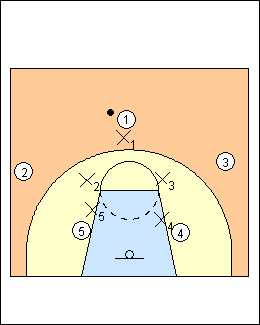 | 1 Dick Bennett Nobody but the on-ball defender goes outside the "pack-line" 16 feet from the basket, except on a dead ball (deny). As a result, there is no help move, only recovery. Do not give up baseline penetration. Two areas of defence are the coach's responsibility - to make sure the other team always attacks a set defence when it gets up the floor (no transition baskets), and don't get beat by a good post player (you know where he is). |
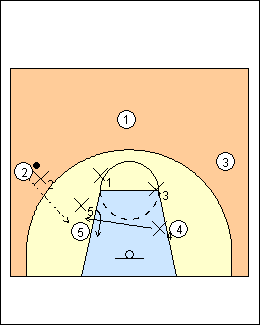 | 2 Post Defence Post defence dictates how you do everything else. Allow no feeds from the top. When the ball is on the wing, 3/4 from the top side, a post feed is OK, don't go for an interception, jump behind the attacker on air time, and it's the same move whether or not you are trapping. You can make a bad player a good player by fronting, he can rebound. Against a good post player, trap big on big, little guys rotate. The other post defender closes the door hard and high to form a 90 degree trap (no split), If the ballhandler dribble releases away, go with him. Seth Miller Packline (basketballcoachingnotes.blogspot.com) - play 3/4 high side to discourage entry passes into the post (on a catch, pop back with your hands up, elbows bent, wall up and hit him with your chest if he dribbles at you). If you go for a steal you better get it, otherwise it's a dunk. 3/4 is great because on a pass from the wing to the top the main concern is a duck-in, you are already on the line, up the line (you can't allow him to step over you for a gut pass). Helpside be close enough to touch your man. |
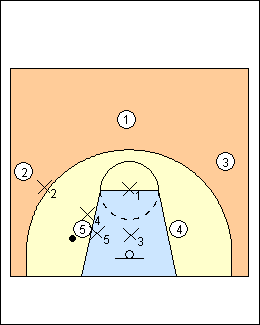 | 3 The defender of the passer denies a return pass nose to nose, the other two defenders form a tandem in the lane, foul line and basket. Being in the pack helps them get there in time. If you don't trap, choke. Ballside defenders attack the ball if defending a non-shooter, hedge if defending a shooter. |
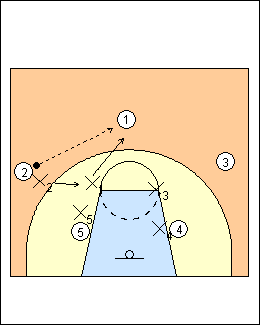 | 4 Ball Pressure On-ball defenders must close-out, take away baseline penetration, take away the rhythm shot, level off a dribbler (force him sideways), bother the shooter, and jump to the ball on a pass (don't over-run, you may have to chase your guy down off a flare screen). On the close-out, run a couple of steps, chop steps, hands high. If you close high you can stop short, don't have to get as close (don't run on to the guy so he just blows by you). Count 1001 then bring the hands down and out the sides, bent elbows, about shoulder level. In the open court, keep a cushion and force changes of direction. Seth Miller - technique on close-outs starts on getting to the ball, once you get there, short choppy steps with butt down and hands high to take away shot and post-feed vision. You're trying to send a wing with the ball to the top of the key. Because post defence is 3/4 from the high side, don't allow a baseline drive from the perimeter, there is no help on the drive, and with one dribble baseline the post attacker can seal. Great defenders absorb jabs with their back foot (Larry Brown), rather than dropping the top foot. |
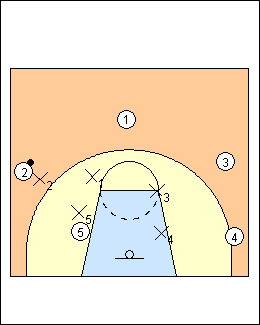 | 5 Off the Ball The key is being able to get to the ball on a pass, not intercept it. Your position in the pack is your help (pinch closer to a quick ballhandler, build a wall), there is no help move, only recovery. Use a closed stance for quicker close-outs, but always see ball and man. Not giving baseline on the wing means not having to rotate under the ball. If there is a pass into the low post, his defender slides behind, so the low weakside defender doesn't have to help, he can stay at home - if he comes much closer than the far lane line, he has come too far. If he rotates across and we allow ball reversal, he can't cover a shooter. Also, if we were to force baseline, we couldn't defend the low post on top and have his defender help on penetration. On a shot, guards check (go to their man) and find the ball, inside players go to their man and stay with him. Seth Miller - on helpside think block and elbow, you don't have to sink under the basket. |
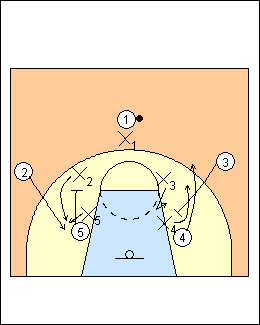 | 6 Screens The xcutter will always chase, although Bennett allows going ballside from the weakside. If you are being screened, you have no responsibility for help or vision, take care of business, chase him down. The xscreener helps in any way he can but within touching distance of his man. On a backscreen, help in the direction the cutter is going. They won't hit the screener as quickly as you think. You must really work on defending screens, by allowing the next pass, they will try to pin you in with screens (although they donít seem to set a lot of screens any more). When you are being screened, chase your guy, the curl is not as dangerous against pack. If you are guarding the screener you are a one-man zone, open up and guard the basket, get between the ball and the rim. Seth Miller - if you've got a screener, you're in help with your eyes on the pass. |
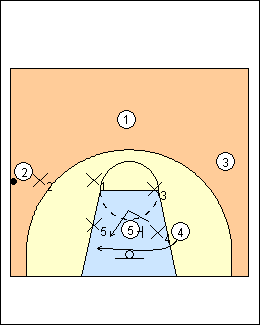 | 7 On a cross-screen, X5 follows the dangerous cut and covers the basket with his back to the baseline, X4 makes a v-move above the screen then back down, stepping above the screen with his left foot and forward pivoting to close down on top if cutter 4 goes under. Defence is recognition, anticipation, reaction, and communication. Work to prevent shot fakes, reaching (including hands on the posts), hands down, silence, lateness on post trapping and choking, and over-helping by bigs in the lane, because their man will get a pass or offensive rebound. Help has to come from the perimeter, if bigs help they have to recover. Seth Miller - by not allowing baseline drives you are set to handle wing ballscreens well, forcing the ballhandler to use a screen and taking away any opportunity to refuse the screen. The xscreener jumps the screen, showing the ballhandler his numbers. The xdribbler goes over the screen and under the hedge. The only switch they will make is when the screener can pop and make a shot from the wing, they will "X switch" with the nearest defender running out at the pop and xscreener running to the front of the rim. They won't hedge on an elbow angle screen, xscreener goes under the screen sliding with the ballhandler until xdribbler can get over the screen and assume on-ball pressure. |
This page was made with Basketball playbook from Jes-Soft